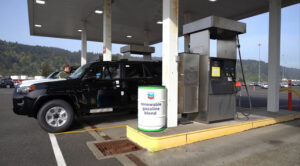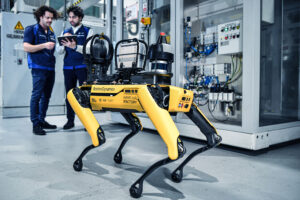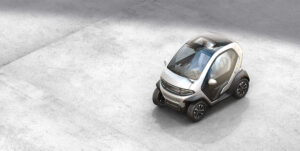
Follow us on social media:
Runtime: 10:08
0:00 Could Lucid Run Out of Money?
1:32 NIO Launching New Affordable Brands in Europe
2:24 Zeekr Expects Big Bucks from U.S. IPO
3:12 NHTSA Ramps Up Autopilot Investigation
4:23 Toyota Fills Shipped Vehicles with Renewable Gas
5:03 Magna Lays Off Fisker Line Workers
5:59 CATL Wants to License Its Tech to Others
6:48 Robot Dog Helps BMW Make Engines in the UK
7:31 Eli Electric Bringing Micro Car to the U.S.
Visit our sponsor to thank them for their support of Autoline Daily: Bridgestone, Intrepid Control Systems, Teijin Automotive and ZF.
This is Autoline Daily, the show dedicated to enthusiasts of the global automotive industry.
COULD LUCID RUN OUT OF MONEY?
Lucid Motors reported its first quarter results and the EV startup sold more vehicles and cut its losses, but it still has some hurdles to clear. Lucid delivered just under 2,000 Air sedans in Q1, which is an increase of 40% compared to last year. And it says it’s on track to make about 9,000 EVs for the whole year. The vehicles it did sell brought in $173 million in revenue, an increase of 16%, and Lucid cut its losses. But it still reported a net loss of $685 million as it gears up to launch new models. The Gravity SUV is supposed to launch before the end of the year and then it says it will come out with a mid-size EV in late 2026 that costs around $48,000. Right now Lucid has just over $5 billion of total liquidity, which it says will last it through next year. Obviously, that’s not a lot of time and its production numbers are still low. But unlike other EV startups, Lucid is majority owned by the Saudi Public Investment Fund, and so far it’s had absolutely no problem raising more money when it needs it. As recently as March it invested another $1 billion in Lucid, bringing its total investment to $5.4 billion since 2018.
NIO LAUNCHING NEW AFFORDABLE BRANDS IN EUROPE
Chinese automaker NIO sold about 160,000 premium EVs last year. While it’s been able to increase deliveries with new models, like most EV makers, its sales have sort of started to plateau. So, NIO announced a new, more affordable sub-brand, called Onvo that it hopes to boost its volumes with. Reports say the new EVs will use batteries from BYD’s subsidiary FinDreams, a first for NIO. Its other suppliers are CATL and CALB. According to CarNewsChina, NIO will launch Onvo in Europe later this year followed by another entry-level brand called Firestar that will have a starting price below 30,000 euros. If that is accurate, it’s not going to be easy to launch two new brands when you’re currently selling under 200,000 vehicles a year.
ZEEKR EXPECTS BIG BUCKS FROM U.S. IPO
Speaking of Chinese automakers, Zeekr, which is a sub-brand of Geely, expects to raise a bunch of money through a U.S. IPO. It’s going to make 17.5 million shares available on the New York Stock Exchange for $18 to $21 each. That would raise nearly $370 million and give it a market cap of over $5.1 billion. However, most of that stock is going to investors. Companies like Geely, Mobileye and CATL are subscribed to buying almost $350 of the nearly $370 million in shares and Geely Chairman Li Shufu will control about 75% of the shareholder voting power after the IPO.
NHTSA RAMPS UP AUTOPILOT INVESTIGATION
The National Highway Traffic Safety Administration or NHTSA is ramping up its investigation into Tesla’s handling of an Autopilot recall. Last month it opened an investigation into Tesla’s over-the-air update because 20 more crashes occurred after the update was issued. And now the safety agency has issued a deadline to Tesla to hand over information about the system. It wants to know how much mileage owners are accumulating using Autopilot and how many times drivers have been warned to put their hands on the wheel before and after the update. NHTSA says Tesla has until July 1 to answer NHTSA’s questions and if the company fails to respond, NHTSA says it could be fined more than $27,000 per day for each violation or up to $135 million in total.
TOYOTA FILLS SHIPPED VEHICLES WITH RENEWABLE GAS
Toyota is now filling up its vehicles coming off ships at the Port of Portland with renewable gasoline before they’re sent off to dealers. The fuel was made by Chevron and it contains more than 50% renewable content. The oil company says it can reduce lifecycle CO2 emissions by more than 40% compared to traditional gasoline. And most importantly, it fills up as fast as normal gas. Toyota worked with Chevron to develop the fuel and last year the two companies filled up a Camry, RAV4 Prime and a Tundra with the renewable gasoline and drove the cars from Mississippi to Texas. And now, they’re expanding the operations to the Port of Portland.
MAGNA LAYS OFF FISKER LINE WORKERS
Well this isn’t too surprising. Magna, which contract manufacturers the Ocean for Fisker, says it doesn’t expect to continue building the model. During the supplier’s first quarter earnings call, Magna CEO Swami Kotagiri said production of the Ocean is currently idled at its plant in Austria, so it laid off 500 workers there and assumes no further production will take place. As you know, Fisker is struggling. Back in March, the New York Stock Exchange de-listed the company because its shares dropped to “abnormally low” prices. Then shortly after that it slashed the price of the Ocean by 39% to help raise money to avoid bankruptcy. CEO Henrik Fisker is also selling his mansion. But that didn’t help and the company still has around 4,700 Ocean models in its inventory. And that’s why Magna isn’t expecting to build anymore going forward.
CATL WANTS TO LICENSE ITS TECH TO OTHERS
China’s CATL is the largest battery maker in the world but it says global battery production needs to be increased to meet future EV demand. The company is building new plants to meet this demand but it also says it’s open to more agreements like the one it has with Ford, who is licensing its technology to build batteries in Michigan. CATL claims that it’s in talks with a dozen automakers and even rival battery makers to boost production. In addition to licensing its battery technology, it will provide support for plant construction and operation services to companies to ensure everything runs smoothly. And while this will bring in more revenue for CATL, it also shows how concerned it is that there isn’t enough capacity to meet future battery demand.
ROBOT DOG HELPS BMW MAKE ENGINES IN THE UK
BMW is using Boston Dynamics robot dog to support the operations at its engine plant in the UK. BMW changed the name from Spot to SpOTTO and it’s equipped with visual, acoustic and thermal sensors, to help it navigate around the plant by itself. BMW is using SpOTTO to collect data for the plant’s digital twin to help with quality assurance and production planning. In addition to that, the dog is being used to monitor the temperature of manufacturing equipment and identify leaks in compressed air lines used in production. BMW says more applications for SpOTTO are being tested out at the plant and it says its testing the use of robotic dogs at its other plants.
THIS MICRO CAR COULD TEST AMERICAN’S WILLINGNESS FOR CHEAP EVs
Lots of people seem to think that Americans would drive low-cost EVs, like the BYD Seagull. We may see that theory put to the test. You may remember Microlino wants to offer its Isetta-like EV in the U.S., which costs around $13,000. And now another company, called Eli Electric, wants to bring another microcar to the States. The Eli Zero is like an enclosed golf cart that costs just under $12,000 and would be limited to 35 mile-per-hour zones. The company says it will come out with a U.S. version with 90 miles of range and it’s $200 refundable deposits right now.
But that’s a wrap for this show. Thanks for making Autoline a part of your day.
Thanks to our partner for embedding Autoline Daily on its website: WardsAuto.com










I think that the deciding factor with Lucid is whether they could sell more vehicles (and enough vehicles to) to stem the deficits they are incurring. So is it a production problem, sales problem or both. The products have been laudable by many reviews (but they are expensive).
We don’t hear the same din from GM’s Supercruise, and Ford’s Bluecruise as we do with Tesla’s Autopilot; would they get the same ‘pass’ that we’re seeing, or are those (GM/Ford) inherently safer?
Renewable gasoline? Does its cost compare to regular or premium? It’s interesting all the new things they are coming up with, as a kid in the 1960’s the cars we had used ancient technology by today’s standards.
Chuck,
Bluecruise and Supercruise are inherently safer. They are only allowed to work on roads which have been specifically mapped. They also watch the users eyes to make sure that they are paying attention instead of relying on a steering wheel sensor like Tesla. In addition to warning beeps, the Bluecruise and Supercruise will discontinue driving if the person ignores all warnings as it will assume there is some type of medical event requiring attention. The Tesla will just beep away at an ignorable volume and you can simply place a rubberband on the wheel to provide constant tension. That allows people to do the dumb stuff you see with Teslas such as reading, or even so far as not being in the drivers seat at all. None of that is possible with Bluecruise or Supercruise.
The micro EVs might sell as inner-city commuters but that’s a pretty limited market. Unless a company buys fleets and rents them I cant see many buyers wanting them as their personal transportation.
NHTSA has opened an investigation into Ford Bluecruise after 2 crashes involving Mach-es at night. There was one fatality.
https://fordauthority.com/2024/04/nhtsa-opens-investigation-into-ford-bluecruise-collisions/
CR rated Autopilot well below “BlueCruise and Super Cruise, but above some other systems.
https://www.consumerreports.org/cars/car-safety/active-driving-assistance-systems-review-a2103632203/
The Tesla system was not too good in “keeping driver engaged” and “Unresponsive Driver” categories.
The little EVs that go only 35 mpg would be good only as a golf cart option with A/C for places like the Villages, but ones like BYD Seagull that go 80 mph would work as commuter cars a lot of places. To sell in the US, they’d probably need to sell for very low prices.
The Ford Authority article and a couple other articles I found said the bluecruise crashes were into vehicles stopped in driving lanes on interstates, at night, one without lights on. That would be a dangerous situation, even for a driver paying attention, if traffic was light. If traffic was stopped, and there were a punch of brake light on other vehicles in front of the stopped ones, there was a problem with the system. The articles I found didn’t say anything about traffic conditions, etc.
I’ve seen a handful of Microlinos around, and while they look spiffy, they’re also truly tiny. Not only very short, but exceedingly narrow. I think fully enclosed vehicles have a realistic minimum size around the defunct Smart 2-seater (which comes across as a grownup car in comparison). Else, electric three-wheelers are now so cheap that something like the MIcrolino just can’t compete, and even I would hesitate to travel more than 10 miles in it.
The BYD Seagull is a full-fledged car, by all accounts, while electric motors mean smooth propulsion. Perfect for getting around a metro area, and really a lot of car for the money. I’m also impressed with the new Xiaomi SU7 that looks like a Taycan crossed with a Lotus. It has a dashboard and real buttons under the touchscreen. Reportedly close to 100K reservations in China.
Yeah I wasn’t talking about the Seagull. Just the 2 seater >35mph micro-cars. The price seems somewhat enticing until you really think about what your getting. I could see a 3-wheeled car being very competitive with these. They have to be similar in crash protection. The under 35 mph must have different crash requirements than normal crash tests. So although you can likely go 80+ mph in a three wheeler you likely have the same protection of not much. Either way that isnt your biggest concern in buying either one. But having something that can go outside the city limits and even if you only travel up to 55-60 I would take that over something limited to 35. I just see those micro-cars being great fleet vehicles but a very small and limited personal vehicle market. Its like buying an eclosed golf cart but paying thousands more. Maybe in other countries they have more use I just dont see it taking off in the US.
In a few days, I’ll be taking an 1100 mile trip on the interstate in a car barely bigger than a Seagull, but a lot faster.
A downside of 3 wheelers, at least in Indiana, is the need to try to dodge potholes and rough manhole covers with 3 tire tracks instead of two.
I saw a Bricklin electric 3 wheeler at an electric car show a couple weeks ago. The guy who had it said it was one of one built.
https://www.prnewswire.com/news-releases/malcolm-bricklin-50-years-of-cars-with-wings-302084359.html
Malcolm Bricklin wasn’t there, that I know of. It was someone else who brought the car there.
My pictures of the Bicklin trike.
https://photos.app.goo.gl/M3F722adrZhKhg4Q7
IMHO, a good place for the Micro Car in the US, would be for drivers education classes in high schools. They’re range would not be an issue, it would familiarize young teens with up coming future tech, wouldn’t have cost the school (potentially) as much to maintain, due to fewer moving parts and at about $12K+, would be as expensive as a used vehicle to purchase new or could even leased. As an EV there may even be a federal, state or local tax credit could be used to cover the cost for the school?
They don’t even have high school driver’s ed where I am. In Florida, they have “virtual” driver’s ed, as if that would help much in actually learning how to drive.
CR’s “October 17, 2023” report is at least six software releases too old. It does not include the much improved, Full Self Driving (FSD) V12 that now uses the Artificial Intelligence (AI) stack.
This weekend, I drove over 1,500 mi using the latest FSD V12.3.6 and software 2024.3.25. Mine was updated last week, less than 10 days ago. You have to test the current, Tesla software to determine if there is a problem . . . which is what I do.
BTW, on this weekend trip, I had one ‘fender bender’ accident AFTER turning off FSD. A kid in a VW struck my passenger side, rear bumper cover as I was half-way into a parking lot. Wished I’d kept it in FSD as now I have to “negotiate” with USAA insurance who initially, falsely claimed I was 90% at fault.
If it had been in FSD, would USAA have considered Tesla 90% at fault? From your description, it sounds like, actually, the driver of the VW might have been 90% at fault.